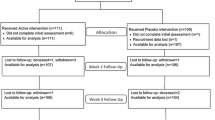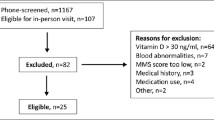Abstract
Hypovitaminosis D in the elderly causes falls and fractures as a result of impaired neuromuscular functions and also may be a reason for nonspecific musculosceletal pain. The aim of this study is to investigate the benefits of a single dose per os or parenterally administrated vitamin D on increasing the quality of life and functional mobility and decreasing the pain in the elderly. The community-dwelling elderly subjects over 65 years age were included in the study. The subjects were given 300.000 IU Vitamin D via per os and parenteral route and assessed after 4 weeks. The serum creatinine, calcium, phosphorous, ALT, ALP, 24-h urine calcium excretion, PTH, and vitamin D levels, as well as VAS (visual analog scale) for pain assessment, functional mobility with TUG (timed up and go test) and quality of life with SF-36 before and after the treatment were evaluated. The serum vitamin D levels were measured by the RIA method. The subjects were divided into four groups each consisting of 30 subjects. The 1st group took i.m. vitamin D, the 2nd group took i.m. placebo, the 3rd group took p.o. vitamin D, and the 4th group took p.o. placebo. The mean age of all the participants was 70.1 ± 4.3 years. There was no difference in the age and gender between the groups (P > 0.05). After treatment, the PTH level of first group was decreased (P = 0.0001) and the vitamin D level increased (P = 0.0001) significantly. In the third group, the PTH level of first group was decreased (P = 0.0001) and the vitamin D level increased (P = 0.004) and the 24-h calcium excretion in urine (P = 0.015) increased significantly. When the pain, the functional mobility, and the quality of life were evaluated, in the first group, the TUG (P = 0.0001) and the VAS (P = 0.0001) decreased significantly, whereas the SF-36 subtitles: physical functioning (P = 0.0001), role physical (0.006), bodily pain (P = 0.0001), general health (P = 0.007), social functioning (P = 0.05), and mental health (P = 0.048) increased significantly. In group two, the VAS (P = 0.001) decreased, the role physical (P = 0.009), and role emotional (P = 0.034) increased significantly; In group three, the TUG (P = 0.0001) and the VAS (P = 0.002) decreased, whereas the physical function (P = 0.0001) and role physical (0.001) increased significantly; In group four, the VAS (P = 0.007) decreased significantly. The megadose vitamin D administration increases quality of life, decreases pain, and improves functional mobility via po or im route in the elderly.
Similar content being viewed by others
References
Dhesi KJ, Moniz C, Close JC, Jackson SH, Allain TJ (2002) A rationale for vitamin D prescribing in a falls clinic population. Age Ageing 31:267–271
MacLaughlin J, Holick MF (1985) Aging decreases the capacity of human skin to produce vitamin D3. J Clin Invest 76:1536–1538
Tsai KS, Wahner HW, Offord KP, Melton LJ 3rd, Kumar R, Riggs BL (1987) Effect of aging on vitamin D stores and bone density in women. Calcif Tissue Int 40:241–243
Gallagher JC, Riggs BL, Eisman J, Hamstra A, Arnaud SB, DeLuca HF (1979) Intestinal calcium absorption and serum vitamin D metabolites in normal subjects and osteoporotic patients: effect of age and dietary calcium. J Clin Invest 64:729–736
Pattanaungku S, Riggs BL, Yergey AL, Vieira NE, O’Fallon WM, Khosla S (2000) Relationship of intestinal calcium absorption to 1, 25-dihydroxy vitamin D [1, 25(OH)2D] levels in young versus elderly women: evidence for age-related intestinal resistance to 1, 25(OH)2D action. J Clin Endocrinol Metab 85:4023–4027
Plotnikoff GA, Qugley JM (2003) Prevalence of severe hypovitaminosis D in patients with persistent, nonspecific musculoskeletal pain. Mayo clinic Proc 78(12):1463–1470
Dhesi JK, Jacson SHD, Bearne LM, Moniz C, Hurley MV, Swift CG (2004) Vitamin D supplementation improves neuromuscuar function in older people who fall. Age Ageing 33:589–595
Basaran S, Guzel R, Coskun-Benlidayı I, Guler-Uysal F (2007) Vitamin D status: effects on quality of life in osteoporosis among Turkish women. Qual Life Res 1689:1491–1499
Gannage-Yared MH, Chemali R, Yaacoub N, Halaby G (2000) Hypovitaminosis D in a sunny country: relation to lifestyle and bone markers. Bone Miner Res 15(9):1856–1862
Diamond TH, Kenneth WH, Rhidroksil PG, Meerkin M (2005) Annual intramuscular injection of a megadose of cholecalciferol for treatment of vitamin D deficiency: efficacy and safety data. Med J Aust 183(1):10–12
Laksmi PW, Setiati S, Oemardi M, Aries W, Siregar P (2007) Correlation between vitamin D concentration and basic functional mobility in elderly women. Acta Med Indones 39:112–118
Peters ML, Patijin J, Lame I (2007) Pain assessment in younger and older patients: psiychometric properties and patient preference of five commonly used measures of pain intensity. Pain Med 8(7):601–610
Walters SJ, Munro JF, Brazier JE (2001) Using the SF-36 with older adults: a cross-sectional community based survey. Age Ageing 30:337–343
Parker SG, Peet SM, Jagger C, Farhan M, Castleden M (1998) Measuring health status in older patients. The SF-36 in practice. Age Ageing 27:13–18
Zamboni M, Zoico E, Tosoni P, Zivelonghi A, Bortolani A, Maggi S, Di Francesco V, Bosello O (2002) Relation between vitamin D, physical performance and disability in elderly persons. J Gerontol A Biol Sci Med Sci 57(1):7–11
Conflict of interest
The authors declare that they have no conflict of interest.
Author information
Authors and Affiliations
Corresponding author
Rights and permissions
About this article
Cite this article
Sakalli, H., Arslan, D. & Yucel, A.E. The effect of oral and parenteral vitamin D supplementation in the elderly: a prospective, double-blinded, randomized, placebo-controlled study. Rheumatol Int 32, 2279–2283 (2012). https://doi.org/10.1007/s00296-011-1943-6
Received:
Accepted:
Published:
Issue Date:
DOI: https://doi.org/10.1007/s00296-011-1943-6




